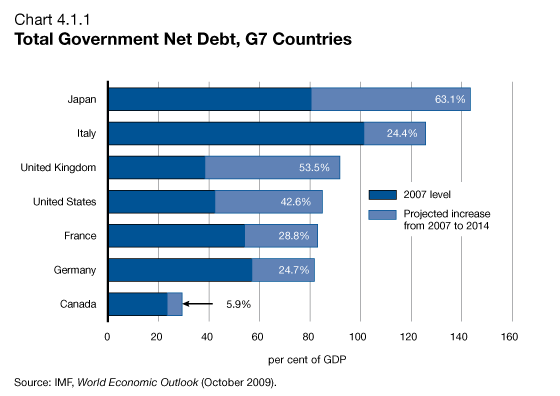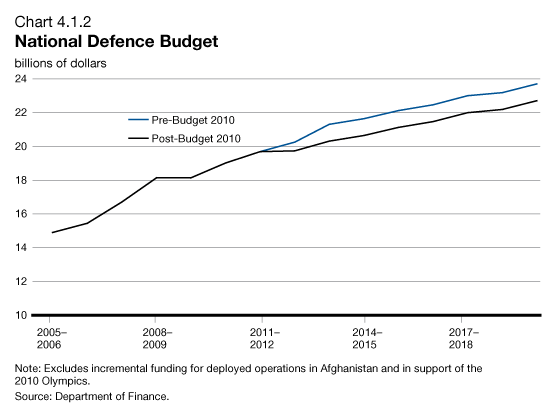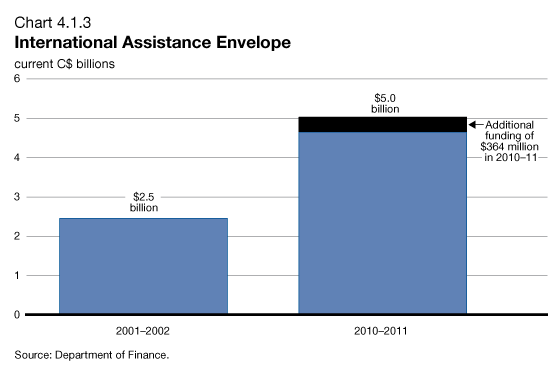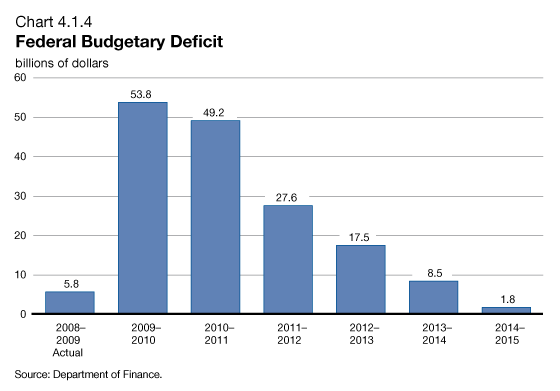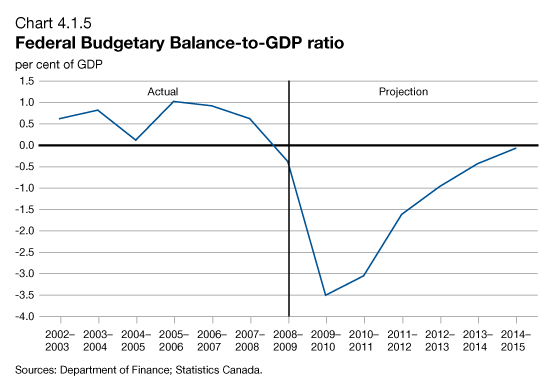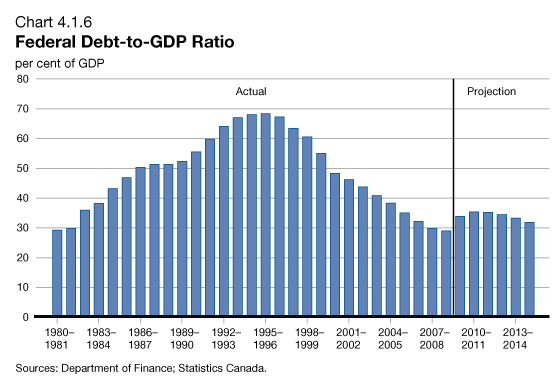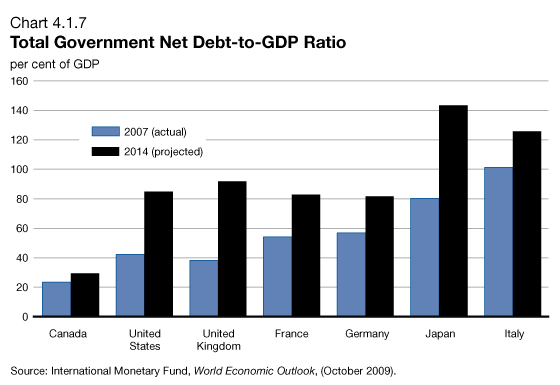Common menu bar links
archived - Chapter 4.1: Plan to Return to Budget Balance
Table of Contents - Previous - Next
Introduction
Canada's Economic Action Plan is a significant and extraordinary response, taken in co-operation with other G20 governments, to the deepest synchronized global recession since World War II. The Action Plan was necessary because governments around the world recognized that the normal cyclical stabilizers—employment insurance programs, the tax system and monetary policy actions—may not have been sufficient to stabilize the economy, raising the risk of a systemic global economic collapse.
The Action Plan is organized around three guiding principles—that stimulus should be:
- Timely: to support the economy when private demand is weakest.
- Targeted: to businesses and families most in need.
- Temporary: to avoid long-term deficits.
All of these principles have been followed. The Action Plan is working. Positive economic signs are emerging. Canadians and businesses in Canada have received significant benefits. With this budget, the Government is starting to phase out specific elements of the stimulus as planned in the 2009 budget.
For example, millions of Canadian families took advantage of the Home Renovation Tax Credit before its expiry on January 31, 2010 and will be able to claim the credit when they file their 2009 income tax returns.
Overall, unprecedented policy efforts appear to have succeeded in limiting the severity of the downturn and fostering a recovery to a degree that was largely unexpected even six months ago. It is now time to plan the exit strategy from the crisis policies, even if its implementation will be progressive.
—Organisation for Economic Co-operation and Development, November 2009
The decision to phase out the stimulus measures as planned reflects the Government's belief that, over the lon term, the private sector is and should be the primary source of jobs and growth. Governments have an important role to play in creating the right conditions for Canadians and businesses to thrive.
This role includes:
- Minimizing the tax burden.
- Reducing disincentives to work and save.
- Supporting high-quality education, training and skills development.
- Promoting competitive trade and investment policies.
- Providing effective regulation and public services.
- Managing public finances responsibly.
As signs of stabilization and recovery in the economy increasingly emerge, the Government will refocus its attention on its long-term economic plan.
Canada entered the global recession in an enviable fiscal position. Canada's total government net debt-to-GDP ratio had declined to 23.5 per cent by 2007. Looking ahead, Canada's net debt burden is projected to increase by 5.9 percentage points between 2007 and 2014. This compares to expected increases of between 24.4 and 63.1 percentage points for other G7 nations (Chart 4.1.1).
Strong fiscal management, founded on the principle that governments should live within their means, is the cornerstone of the Government's economic plan. A balanced budget is not an end in itself. Rather, it is a means to better jobs and stronger, sustainable growth. Balancing the budget is the most direct way of ensuring that Canada's social infrastructure is sustainable for the long term.
- Returning to balanced budgets will minimize the amount of revenues absorbed by debt charges, thereby allowing ongoing investments in the areas that are critical to Canada's long-term growth and prosperity—infrastructure, education and training, science and technology, health care and elderly benefits.
- Returning to balanced budgets will provide Canadians and Canadian businesses with confidence that both their tax levels and public services are sustainable over the long term. This will also ensure fairness and equity toward future generations, by avoiding future tax increases or reductions in government services in the face of an aging population.
- By keeping debt levels low, the Government helps to keep interest rates low. High government debt in other countries has translated into higher borrowing costs for their economies. As investors become more concerned about rising debt loads around the globe, our strong fiscal position is helping insulate Canada from rising risk premiums and higher borrowing costs.
Budget 2010 Plan for Returning to Balance
To ensure that the economic recovery is secured, the Government will complete the implementation of the second year of Canada's Economic Action Plan so that recent positive economic growth is supported and jobs are maintained and created. Budget 2010 delivers on this commitment.
Budget 2010 sets out a three-point plan to bring the budget back to balance.
First, the Government will follow through on the "exit strategy" that is built into the Action Plan by ensuring that the temporary measures end as scheduled.
Second, the Government will put in place targeted measures to direct program spending growth now that will build over the medium term, when the recovery is secure. This will provide Canadians and Canadian businesses with certainty that the fiscal position of the Government is solid, that tax cuts are permanent and core program spending secure.
Third, the Government will undertake a comprehensive review of government administrative functions and overhead costs in order to identify opportunities for additional savings and improve service delivery. It will also continue with and augment a number of review processes, including strategic reviews.
In achieving this plan:
- The Government will not raise taxes. It will ensure that the costs of goods and services intended to be charged to recipients are recovered as appropriate.
- The Government will not cut major transfers to persons—including those for seniors and children and Employment Insurance. These important benefits for Canadians will not be reduced.
- The Government will not cut major transfers to other levels of government in support of health care and social services, Equalization and the gas tax transfer to municipalities. The federal government will do its share to fund these essential services.
Ending the Economic Action Plan on Time
Governments around the world are working together to stimulate their economies through significant short-term expenditures. These actions have been endorsed internationally, but with an emphasis on the need for sustainable medium-term fiscal plans. At the Pittsburgh Summit in September 2009, G20 Leaders committed to follow through on their stimulus plans in the near term, while preparing strategies to wind down stimulus and improve their fiscal positions as the recovery is established.
Canadians expect federal, provincial and municipal governments to work together to stimulate the economy and create and maintain jobs. But they also expect governments to return to balanced budgets as quickly as possible once the recovery takes hold. That is why many elements of the Economic Action Plan are time-limited. For the most part, funds are only available through March 2011.
Allowing the temporary elements of the Action Plan to wind down, as scheduled, is the first step in the Government's plan to return to balance over the medium term. This alone will cut the budget deficit almost in half between 2009–10 and 2011–12. The Government is starting to phase out specific elements of the stimulus, as planned in the 2009 budget.
- In December, the Government set a deadline of January 29, 2010, for partner authorities to secure firm commitments to implement projects. This deadline was set to allow for projects to be completed by March 31, 2011. Projects with partner authorities have now been finalized. In areas where funds were not committed, these have been reallocated to other priorities.
- On January 31, 2010, the Home Renovation Tax Credit came to an end after successfully boosting activity in the home renovation sector. Canadians will see the benefits upon filing their 2009 income tax returns.
Targeted Measures
The second element of the Government's plan to bring the budget back to balance is to put in place targeted measures to reduce the rate of growth of spending that will build over the medium term. Budget 2010 announces $17.6 billion in savings measures over the next five years. Each of these spending growth restraint measures is described below.
Restraining Growth in National Defence Spending
In recent years, the Government has made major, necessary investments in the country's military capabilities in support of the Canada First Defence Strategy, the Government's long-term vision for the Canadian Forces. The Canada First Defence Strategy is a long-term commitment to modernize the Canadian Forces. The strategy sets out key objectives of growing the forces, recapitalizing air, land and naval fleets and other major equipment, restoring infrastructure, and ensuring the Canadian Forces are ready to deploy in the defence of Canada and Canada's interests both at home and abroad. The Canada First Defence Strategy continues to point the way forward for Canada's military.
In addition to incremental funding received for deployed operations, National Defence's annual expenses have increased from $15 billion in 2005–06 to $18 billion in 2008–09. In 2008–09, National Defence spending represented approximately one-fifth of total government direct program spending on an annual basis. These investments have strengthened the Canadian Forces and produced tangible results, as most recently demonstrated by the Afghanistan mission, support for relief efforts in Haiti, and the provision of security at the 2010 Winter Olympics in Vancouver.
The Government remains committed to continuing to build the Canadian Forces into a first-class, modern military. However, as part of measures to restrain the growth in overall government spending and return to budget balance in the medium term, the Government will slow the rate of previously planned growth in the National Defence budget. Budget 2010 reduces growth in National Defence's budget by $525 million in 2012–13 and $1 billion annually beginning in 2013–14. Defence spending will continue to grow but more slowly than previously planned (Chart 4.1.2).
By implementing this measure beginning in 2012–13, the Government will ensure that it does not adversely affect military operations during the current Afghanistan mission, and that National Defence has sufficient time to adjust its long-term expenditure plans. The Government is confident that the long-term objectives of the Canada First Defence Strategy can be achieved and that the Canadian Forces will continue to fully meet its three key roles: defending Canada, defending North America and contributing to international peace and security.
National Defence has already begun work on a comprehensive strategic review to ensure its resources are fully aligned with the priorities set out in the Canada First Defence Strategy. This review will identify measures necessary to implement the Budget 2010 decision.
International Assistance Envelope
In 2002, Canada committed to double international assistance by 2010–11. Budget 2010 fulfills this commitment by increasing the International Assistance Envelope (IAE) by $364 million, or 8 per cent, in 2010–11, bringing it to $5 billion (Chart 4.1.3).
For planning purposes, the Government had provisioned for annual IAE growth of 8 per cent. With the achievement of the $5-billion aid target, future IAE spending levels will be capped at 2010–11 levels and will be assessed alongside all other government priorities on a year-by-year basis in the budget. Relative to the planning track that was assumed in the September 2009 Update of Economic and Fiscal Projections, which assumed automatic ongoing growth for international assistance spending of 8 per cent per annum, this results in savings of $438 million in 2011–12, rising to $1.8 billion by 2014–15.
International assistance remains a priority for the Government. Honouring the commitment to double our international assistance budget by 2010–11 will mean significant new ongoing resources to allow Canada to respond to global challenges with strong leadership, including support for reconstruction in Haiti and our G8 and G20 Summit priorities. More details on these initiatives can be found in Chapter 3.5.
Containing the Administrative Cost of Government
The Government is also proposing to reduce the rate of growth of its operating expenditures and improve efficiency while lowering the rate of growth in the size and operations of the public service.
The Government will lead by example, introducing legislation to freeze the salaries of the Prime Minister, Ministers, Members of Parliament and Senators for 2010–11, 2011–12 and 2012–13. It will also freeze the overall budget of Ministers' offices and calls on Members of both Houses of Parliament to do the same. It will also maintain the freeze at 2008–09 levels on departmental spending on travel, conferences and hospitality.
This budget proposes two further significant actions to reduce the growth in operating expenses.
- For 2010–11, departmental budgets will not be increased to fund the 1.5-per-cent increase in annual wages for the federal public administration. Employees will continue to see their wages increase as set out in collective agreements and the Expenditure Restraint Act, which is in effect through 2011. However, departments will be required to reallocate from the remainder of their operating budgets to fund these increases.
- For 2011–12 and 2012–13, operating budgets of departments, as appropriated by Parliament, will be frozen at 2010–11 levels. Departmental spending is appropriated through the Main and Supplementary Estimates. The Government tabled the 2010–11 Main Estimates on March 3, 2010. The spending in the Main Estimates is generally consistent with the program expenses set out in the budget. However, the Estimates do not take into account measures announced in Budget 2010 or expected adjustments to fund cost pressures related to essential services, payments that arise from liabilities and other contingencies. An allowance for these adjustments is included in the fiscal framework. Treasury Board will set departmental operating spending levels for 2011–12 and 2012–13 at 2010–11 amounts, adjusted to reflect the expiration of operating budget authorities to deliver the Economic Action Plan. Practically speaking, salary and operating budgets of departments will be frozen at their 2010–11 levels in 2011–12 and 2012–13.
While the Department of National Defence will be subject to the overall operating budget constraint, the Defence escalator will continue to apply over those years, such that the Defence budget will continue to increase.
The Government expects that other federal organizations, for which expenses are not appropriated by Parliament (for example, enterprise Crown corporations), will follow suit and freeze their operating expenses.
Given the constraints on departments' operating budgets, the Government will engage with public sector bargaining agents and will assess measures taken by other jurisdictions in Canada to ensure that total costs of compensation are reasonable, the organization of work is effective, technology is used appropriately to drive productivity, and the federal public service maintains its reputation for excellence. The Government will also continue to examine ways in which all compensation costs, including benefits, could be better managed.
Actions to reduce growth in operating expenses proposed in this budget are projected to save $0.3 billion in 2010–11, $0.9 billion in 2011–12 and $1.8 billion in 2012–13, as reflected in Table 4.1.1 below.
Review of Government Operations
The third element of the Government's plan to return the budget to balance is to undertake, continue with, and in some cases augment, a number of review processes aimed at reducing costs while improving efficiency. Over time this should result in a reduction in the size of the public service.
- Strategic reviews, through which departments assess all their programs and identify 5 per cent of the lowest-priority and lowest-performing ones, will continue. Strategic reviews are carried out under the leadership of the President of the Treasury Board. Over the first two years of the strategic review exercise, almost $1.0 billion has been identified in ongoing annual savings. This budget proposes savings in respect of the 2009 round of strategic reviews that reach $287 million in 2012–13. To maximize savings in future strategic reviews, departments will no longer be asked as a matter of course to suggest reinvestments of strategic review savings. Detailed outcomes of the 2009 round of strategic reviews are provided in Annex 2.
- The Government will undertake a comprehensive review of government administrative functions and overhead costs in order to identify opportunities for additional savings and improve service delivery. Simplification of processes and delivery mechanisms will improve access to government services and reduce costs of program delivery. The Government will report on the results of this review in the 2011 budget.
- The Government will ensure that, as part of its ongoing assessment processes of grants and contributions, including renewal of program terms and conditions, the funding provided to organizations is tied to furthering government priorities and achieving results for Canadians.
- The Corporate Asset Management Review is continuing, consistent with the Budget 2009 commitment. The Review assesses selected assets under the leadership of the Minister of Finance, with a view to improve their efficiency and effectiveness and ensure that resources of the Government are employed in ways that focus on the priorities of Canadians. Reviews consider a wide set of options for the future of selected assets, including the status quo, amendments to current mandates or governance, and divestment. A systematic review of corporate assets is a normal part of good governance and contributes to the ongoing reallocation of financial resources from low to high priorities in order to maximize economic benefits to taxpayers.
- The Government is proceeding with a reduction of 245 Governor in Council (GiC) positions. This reduction represents 9.1 per cent of the approximately 2,700 positions covered by the GiC review announced in the 2009 budget. This streamlining exercise will provide for more effective governance and operations and strengthen the management of Canada's federal agencies, boards, commissions and Crown corporations.
In addition to the expenditure restraint announced above, this budget introduces a number of measures intended to protect the integrity of the Canadian tax system. The introduction of these measures will yield $355 million in savings in 2010–11, rising to $625 million by 2014–15. These measures are detailed in Chapter 3 and Annex 5.
In total, Budget 2010 savings measures amount to $17.6 billion in savings. Table 4.1.1 outlines these major actions. As a result of the actions taken in this budget, average annual growth in direct program spending after the expiry of the Economic Action Plan will slow to 1.3 per cent.
| 2009– 2010 |
2010– 2011 |
2011– 2012 |
2012– 2013 |
2013– 2014 |
2014– 2015 |
Total | |
|---|---|---|---|---|---|---|---|
| (millions of dollars) | |||||||
| Restraining growth in National Defence spending |
525 | 1,000 | 1,000 | 2,525 | |||
| International Assistance Envelope |
438 | 869 | 1,337 | 1,842 | 4,486 | ||
| Containing the administrative cost of government |
300 | 900 | 1,800 | 1,800 | 2,000 | 6,800 | |
| 2009 strategic reviews | 152 | 248 | 287 | 288 | 288 | 1,262 | |
| Tax fairness—closing tax loopholes |
20 | 355 | 440 | 500 | 565 | 625 | 2,505 |
| Total | 20 | 807 | 2,026 | 3,981 | 4,990 | 5,755 | 17,578 |
| Note: Totals may not add due to rounding. | |||||||
Budget 2010 Plan for Returning to Balance: Results
Chart 4.1.4 shows the projected deficit for this fiscal year and the next five years. This projection takes into account the wind-down of the Economic Action Plan, the savings from direct program spending growth restraint outlined above, the impact of the new actions outlined in Chapter 3, and the impact of recent economic developments on government revenues and expenses, as described later in this chapter.
- The deficit is projected to be cut by almost half from $53.8 billion in 2009–10 to $27.6 billion in 2011–12. This significant drop in the deficit for the most part reflects the Government's commitment to make certain that Action Plan stimulus measures expire as scheduled on March 31, 2011.
- The deficit is projected to be cut by two-thirds from $53.8 billion in 2009–10 to $17.5 billion in 2012–13.
The projected deficit in 2009–10 of 3.5 per cent of GDP is considerably below the deficits recorded in previous recessions of 5.6 per cent of GDP in 1992–93 and 7.6 per cent of GDP in 1982–83. By 2014–15, the deficit measured in relation to the size of the economy is projected to be 0.1 per cent of GDP (Chart 4.1.5).
An important measure of fiscal sustainability is the debt burden as measured by the debt-to-GDP ratio. Reductions in the debt burden in recent years have provided Canada with the flexibility to put in place measures to support the economy that are sustainable. Chart 4.1.6 shows that the federal debt, measured in relation to the size of the economy, is projected to increase from 29 per cent of GDP in 2008–09—the lowest debt ratio in 29 years—to a peak of 35.4 per cent in 2010–11. The debt ratio over this year and next will be about equal to the ratio in 2005–06, when the Government recorded a $13.2-billion surplus. In 2011–12, following the expiry of the measures in the Economic Action Plan, the debt ratio is projected to fall once more to 35.2 per cent of GDP, and to continue to fall to 31.9 per cent of GDP by 2014–15.
The total government net debt-to-GDP ratio in Canada[1] is the lowest of all G7 countries and will continue to be so over the medium term (Chart 4.1.7). In fact, by 2014, Canada's debt-to-GDP ratio is expected to be proportionately much lower than in other G7 countries than it is now.
[1] Includes federal, provincial-territorial and local governments, as well as the Canada Pension Plan and the Québec Pension Plan.

